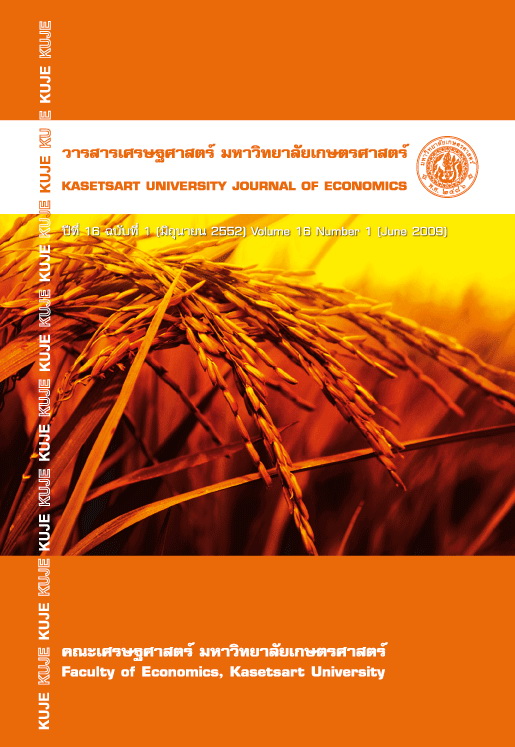การประเมินรูปแบบสมการการผลิตข้าวในประเทศไทย
Main Article Content
Abstract
บทคัดย่อ
บทความนี้ประเมินหารูปแบบสมการการผลิตข้าวที่เหมาะสมที่จะนำไปใช้วิเคราะห์หาระดับประสิทธิภาพการใช้ปัจจัยการผลิตในที่นี้พิจารณาปัจจัยปุ๋ยเคมีและสารเคมีกำจัดศัตรูพืช การศึกษาอาศัยการตรวจเอกสารสมการการผลิตข้าวของประเทศไทยย้อนหลัง 20 ปี รวมจำนวน 41 สมการ และสำรวจครัวเรือนเกษตรกรในภาคกลางและภาคเหนือ 94 ราย โดยเก็บข้อมูลของปีการเพาะปลูก 2542/43 2543/44 และ 2545/46 รวมจำนวน 282 ตัวอย่าง เพื่อใช้ศึกษาเชิงประจักษ์ การวิเคราะห์จำแนกตามรูปแบบสมการ การผลิต โดยนำมาคำนวณหามูลค่าของผลิตภาพส่วนเพิ่มของปัจจัยการผลิต ณ ราคาปัจจุบัน และนำค่าที่ได้มาเปรียบเทียบกับราคาของปัจจัยการผลิตนั้นรวมถึงการหาระดับการใช้ปัจจัยการผลิตที่เป็นอยู่ ผลการ ศึกษาพบว่าการวิเคราะห์โดยใช้สมการการผลิตแบบ translog ที่รวมสมการควบคุมความเสียหาย (damage control function) ไว้ด้วย จะมีความเหมาะสมที่สุดที่จะนำมาใช้ประเมินประสิทธิภาพ การใช้ปัจจัยการผลิต การวิเคราะห์ตามแนวคิดดังกล่าวจะช่วยไม่ให้เกิดการประเมินประสิทธิภาพของการใช้ปัจจัยการผลิตสูงเกินจริง จากการศึกษาเชิงประจักษ์ยืนยันว่า แนวทางการศึกษานี้สามารถนำมาใช้วิเคราะห์ได้อย่างเหมาะสม ผลการศึกษายังชี้ว่าการผลิตข้าวในประเทศไทยมีการใช้สารเคมีกำจัดศัตรูพืชมากเกินไป จึงมีความจำเป็น เร่งด่วนที่ต้องมีการกำหนดนโยบายและมาตรการควบคุมและลดการใช้สารเคมีกำจัดศัตรูพืชอย่างจริงจัง
คำสำคัญ: สมการการผลิต ประสิทธิภาพการผลิต สมการควบคุมความเสียหาย
Abstract
This paper assesses an appropriate production function approach for analyzing the efficient use of inputs in rice farming in Thailand. The farm inputs considered are fertilizer and pesticide. The paper reviews the rice production functions in Thailand in the past 20 years covering41 functions. The farm-household survey of 94 respondents was also conducted in the Central and North of Thailand for 3 crop years, in 1999/00, 2000/01 and 2002/03. This provides a set of panel data of 282 samples to be used for the empirical analysis. The analysis is classified by the functional forms of the production functions. The present value of marginal product (VMP) of each function is calculated. The VMP is compared to the input price. Subsequently, the efficiency level of the input use can be identified. The actual level of input use is also evaluated. The results reveal that using the translog production function in consideration with the damage control function would be the most appropriate approach for assessing the efficient input uses in rice production in Thailand. This would help the analyst to avoid overestimating the efficiency of rice input. The empirical results confirm that the approach can be appropriately applied in the analysis. The results also show evidence of overuse of pesticides in Thai rice farming, which suggests an urgent need for policy and regulation to control and reduce the use of pesticide.
Keywords: production function, production efficiency, damage control function
Article Details
The paper is published under CC BY-NC-ND, in which the article is freely downloaded and shared in its original form non-commercially and its citation details are identified.


